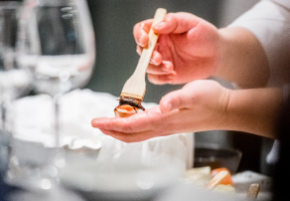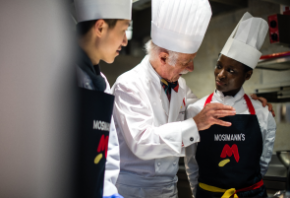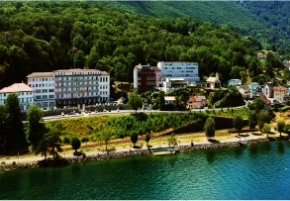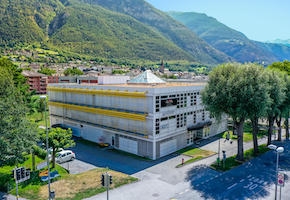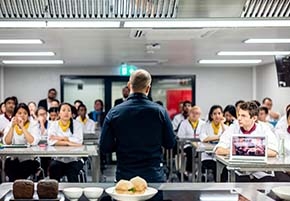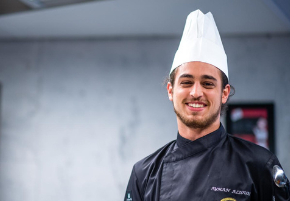- About
- Programs
- Campus Life
- Career Services
- Admissions
- News & Events
- Alumni
The Menu Review: Culinary Satire Served Just Right
Indulge in culinary satire with 'The Menu' movie review. Discover the witty take on gastronomy as we serve you the review of this captivating film. Explore 'The Menu' reviews now!
The dark humor movie The Menu has something for all tastes. Everything at Hawthorn, the ultra-exclusive restaurant on a private island run by chef Julian Slowik (portrayed by Ralph Fiennes) is at the extreme – from the sourcing of the ingredients (everything grown or harvested on the island, sometimes just moments before being prepared) to the guests (acclaimed food critics, obsessive foodies, rich finance bros, and self-absorbed celebrities). Everything about the entire experience is cliché and over-the-top, exaggerating actual trends and tendencies of today’s highest level cuisines.
The food at Hawthorn is exquisite, with each dish telling a story, not unlike many of the “stories” served by some of the top chefs today. The difference with Chef Slowik’s stories is that his are dark and morbid and make reference to some of the brutal actualities of the hospitality industry today. Others are over-the-top references to the sometimes outlandish dishes that are becoming part of gastronomy’s everyday inventory.
Take for example the “breadless bread plate” – a plate of accoutrements to dip some bread in, but no bread to dip – this coming from a restaurant famous for its bread, no less. The idea seems preposterous, however the patrons view it rather genius, solely based on having come from the best chef, so it must be a great thing. Then a dish is served accompanied with personalized tortillas deliciosas, with each heirloom masa disk revealing some dark secret of the individual guests. Thus it begins to emerge that something a bit more sinister is planned for the Chef’s Table. Who would expect less, after all, from a chef who is played by Voldemort?
The film tackles, in a very appetizing way, the ever-growing conflict and controversies of the restaurant world. It addresses the physical, financial, and psychological stresses that share the plate of being at the top of a dog-eat-dog business. These constant pressures are pinned onto both Front of the House (FOH) and Back of the House (BOH) staff by diners who often eat at a venue just for the opportunity to claim: “I’ve eaten there”. Chefs need to constantly jump through hoops for food critics who have the ability to destroy a restaurant’s reputation and success solely with the swipe of a pen, with no regard to the countless hours and amount of sweat and hard work put into the work. Consider the Chef’s Table bringing know-it-all foodies who think they know more than the chef and take away the fun mystery of dining out, or the uber-rich clients who dine at a restaurant for status, just because it is the most expensive restaurant in town.
Unbeknownst to them, the diners at Hawthorn have been curated especially for their corrupt qualities to indulge in one final meal orchestrated by the chef, which culminates on a sweet note of gooey-chocolaty-torched-goodness. Chef Slowik’s true joy of cooking will eventually be revealed with the preparation of a most unexpected and iconic dish – one which would be ironically unheard of at a restaurant that puts “style over substance”.
Regardless of whether you think avant-garde cooking has gone too far or not, or if you find that this is the fault of over-demanding clients, I believe that we can all agree that at times the envelope is pushed just to be pushed. I am a proponent of modern cooking, however I do fear at times that some chefs focus so hard on doing something new and catchy that they sometimes forget about the fundamentals of cooking. I do not wish the culinary world to focus on dishes that are gimmicky, just for gimmickry’s sake, while losing sight of classics. As a chef, this film rang true to me on both sides of the equation: I can appreciate the hard work put into creating and executing menus on a daily basis for the dining pleasure of restaurant guests, and at the same time question if inordinate presentations and techniques have not gone too far as to obscure the actual food.
The food on its own in The Menu is worth watching the film for. The dishes were created for the film by Dominique Crenn, a 3-Michelin Star Chef in San Francisco, California (Atelier Crenn). It is superbly presented, and truly represents today’s modern food culture. The kitchen scenes, with hyper-organized tweezer-wielding cooks following the chef with a cult-like discipline, was also an exaggerated accuracy, and a fun depiction of the industry.
Conclusion of 'The Menu' review : The Menu was easily the best movie I saw all year (2022). I give it 5 spoons (or 5 forks, or 5 stars, or whatever).
#Academics


